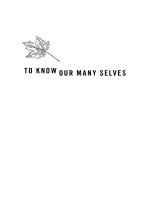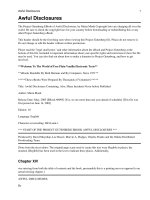- Trang chủ >>
- THPT Quốc Gia >>
- Hóa
Many ecosystems
Bạn đang xem bản rút gọn của tài liệu. Xem và tải ngay bản đầy đủ của tài liệu tại đây (7.13 MB, 8 trang )
Life Sciences
Standards
Preview
Standard Set 3. Life Sciences
3. Living organisms depend on one
another and on their environment for
survival. As a basis for understanding
this concept:
3.a. Students know ecosystems can
be characterized by their living and
nonliving components.
by Shelly Krishnamurty
Genre
Nonfiction
Comprehension Skill
Predict
Text Features
•
•
•
•
Captions
Labels
Map
Glossary
Science Content
Ecosystems
Scott Foresman Science 4.4
ISBN 0-328-23551-2
ì<(sk$m)=cdf bd< +^-Ä-U-Ä-U
Vocabulary
canopy
climate
coral reef
desert
rain forest
symbiosis
understory
Many
Ecosystems
by Shelly Krishnamurty
Picture Credits
Every effort has been made to secure permission and provide appropriate credit for photographic material. The
publisher deeply regrets any omission and pledges to correct errors called to its attention in subsequent editions.
Unless otherwise acknowledged, all photographs are the copyright of Dorling Kindersley, a division of Pearson.
ISBN: 0-328-23551-2
Copyright © Pearson Education, Inc. All Rights Reserved. Printed in the United States of America.
This publication is protected by Copyright, and permission should be obtained from the publisher prior to any
prohibited reproduction, storage in a retrieval system, or transmission in any form by any means, electronic,
mechanical, photocopying, recording, or likewise. For information regarding permission(s), write to
Permissions Department, Scott Foresman, 1900 East Lake Avenue, Glenview, Illinois 60025.
1 2 3 4 5 6 7 8 9 10 V010 13 12 11 10 09 08 07 06
An Ecosystem’s Parts
A system is formed by many parts working together for
a purpose. Every part of a system is important, whether it is
living or nonliving. A system will not work well if a part is
missing or damaged. In a car, the driver works with parts of
the car to form a system. Different parts work together to
keep the system going. For example, the pedals and steering
wheel let the driver control the speed and direction of the car.
One kind of system is an ecosystem. An ecosystem is all
the living and nonliving things in an environment and the
many ways they interact. An ecosystem may be as large as a
tundra. It may be as small as a decaying mushroom.
Nonliving and Living Parts Together
An ecosystem is a type of system. It is made up of an
environment’s living and nonliving things. It is also made up
of their interactions. Animals and plants, along with fungi,
protists, and bacteria, are the living parts of an ecosystem.
The nonliving parts of an ecosystem include air, water,
soil, and light. Temperature, landforms, and climate are also
nonliving parts of an ecosystem. Climate is the average
weather conditions in an area over a long period of time.
Climate changes can affect
these lichen and mosses.
This Arctic fox is a living part
of the tundra ecosystem.
2
3
The Impact of Nonliving Parts
on Living Parts
Organisms cannot live in an environment that does not
meet their needs. Some plants and animals will live and grow
better in certain environments than others. Others will not
survive at all.
For example, tundra is very cold. Plants and animals that
live there must be able to survive in the frigid climate. The
Arctic willow lives in the tundra of Alaska and Canada. The
ground is frozen in the tundra, so the roots of the Arctic
willow do not grow straight down. Instead, its roots are
shallow and spread out.
Tundra
A tundra is a cold, dry region. It is so cold that
the ground beneath the topsoil always stays
frozen. Trees cannot grow in the tundra, but
some grasses and other plants can.
River
Rivers are freshwater ecosystems. Different
organisms live in different parts of a river, but
most are found where it is calm. Duckweed,
algae, water moss, fish, and frogs live in rivers.
Grassland
Grasslands are covered with grasses, such as
purple needlegrass, buffalo grass, or blue
grama. They get a medium amount of rain.
Swamp
Swamps are wetlands. Wetlands are covered
with water for some or all of the year. Willow,
cypress, and cottonwood trees grow in some
swamps. Animals such as alligators and
cottonmouth snakes live in some swamps.
4
5
Desert Ecosystems
A desert is an ecosystem that gets very little precipitation,
usually less than 25 centimeters in a year. Deserts can have
sand dunes, mountains, and other landforms. Many deserts
have hot days and cool nights. Other deserts are cold.
To survive in the dry climate, desert plants have special
structures. Some have large, shallow root systems. Since the
roots are near the surface, they can take up rainwater quickly.
Many kinds of bushes and shrubs grow in deserts. A shrub is
a woody plant. Instead of having a single trunk like a tree, it
often has branches that go out from its base.
Animals are also adapted to life in the desert. Many rest
during the hot day. They move around more when it is cooler.
Usually they hunt when it is nearly or completely dark.
Low Desert and High Desert
California’s Colorado Desert is a low desert. It ranges from
below sea level to 915 meters above sea level. There are sandy
areas, salt flats, and low mountains. It gets 5–15 centimeters of
rain per year. The rain can cause floods. Jackrabbits, bighorn
sheep, desert tortoises, roadrunners, and rattlesnakes live
among shrubs and cholla cactus in the low desert.
California’s Mojave Desert is a high desert. The Mojave
ranges from about 915 to 3353 meters above sea level. It is hot
in summer, but it can snow in winter. There are mountains,
sand hills, and flat places in the Mojave. It gets between
7 and 26 centimeters of rain or snow per year. Bighorn sheep,
coyotes, and bats live in the Mojave. So do plants such as
Joshua trees, sagebrush, and pinyon pines.
Sagebrush
Bighorn sheep live in
both low deserts and
high deserts.
6
7
Rain Forests
A rain forest is any ecosystem that has large amounts of
rain and thick plant growth. Most rain forests are tropical.
They are found in hot and humid places near Earth’s equator.
Some of these forests get over 3 meters of rain each year!
The rain forest’s top level is the canopy. Tree branches
and leaves tangle together to form it. Most rain forest animals
live in the canopy. Monkeys, as well as birds such as the
scarlet macaw, live there.
Canopy
Animals that live in the canopy include
monkeys, brightly colored birds, and
butterflies. Some animals may spend
their whole lives in the canopy.
Under the canopy is the understory. Orchids, vines, small
trees, ferns, and other plants that need shade grow there.
The forest floor is the rain forest’s lowest level. It can be
bare or covered with a thin layer of dead and decaying leaves.
Often the ground there is moist or soggy.
Temperate Rain Forests
Have you ever visited the redwood forests along
California’s northern coast? They make up part of North
America’s temperate rain forest. This rain forest runs from
Alaska down into Canada, and then through Washington,
Oregon, and into northern California.
Temperate rain forests are cooler than tropical rain forests.
But they still get a lot of rain. Like tropical rain forests, they
also have a lot of plants and animals.
Temperate rain forests grow on the
northwest coast of North America,
from Alaska to California.
8
9
Coral Reef: “Rain
Forest of the Ocean”
A coral reef is a ridge or mound formed by the skeletons
of certain tiny sea animals called coral polyps. Coral grows
and then dies. Coral skeletons build up the reef over time.
Coral reefs have a lot of marine, or ocean, life. Sea turtles,
clownfish, starfish, and sponges live in coral reefs. So do sea
worms, clams, oysters, sea slugs, algae, and seagrass. These
many species show why coral reefs are sometimes called the
“rain forests of the oceans.”
The coral that form reefs need plantlike algae to survive.
This algae lives inside the coral and makes oxygen and food
the coral can use. The algae benefit too. They get carbon
dioxide and shelter from the coral. This kind of relationship
between two organisms is called symbiosis. In symbiosis, the
relationship helps one or both of the organisms.
One-celled algae are the main producers in marine
ecosystems. Some algae can only grow in warm, shallow
waters where there is a lot of sunlight. Coral that grows in
shallow water need these algae in order to live. This is one
reason why certain corals grow better in warm, shallow water.
Without symbiosis, coral would not be
able to survive. This would harm the
many organisms that depend on coral.
Certain kinds of sharks and starfish
live in and around coral reefs.
10
11
Glossary
What did you learn?
1. What makes up an ecosystem?
canopy
the top level of a rain forest, formed by tree
branches, leaves and vines tangled together
climate
the average weather conditions in an area
over a long time
coral reef
a ridge or mound in warm, shallow ocean
waters formed by the skeletons of certain
tiny sea animals called coral polyps
desert
an ecosystem that receives very little
precipitation
rain forest
an ecosystem that has large amounts of
precipitation and thick plant growth
symbiosis
a relationship between two organisms that
helps one or both of the organisms
understory
the area of a rain forest below the canopy
12
2. What are two types of ecosystems?
3. How do coral and algae live in symbiosis?
4.
Suppose you just visited one of the
ecosystems described in the book. Write a description of
what you saw, smelled, felt, or heard. Include details to
make readers feel like they were there.
5.
Predict Predict what would happen if the algae in a
coral reef died.









